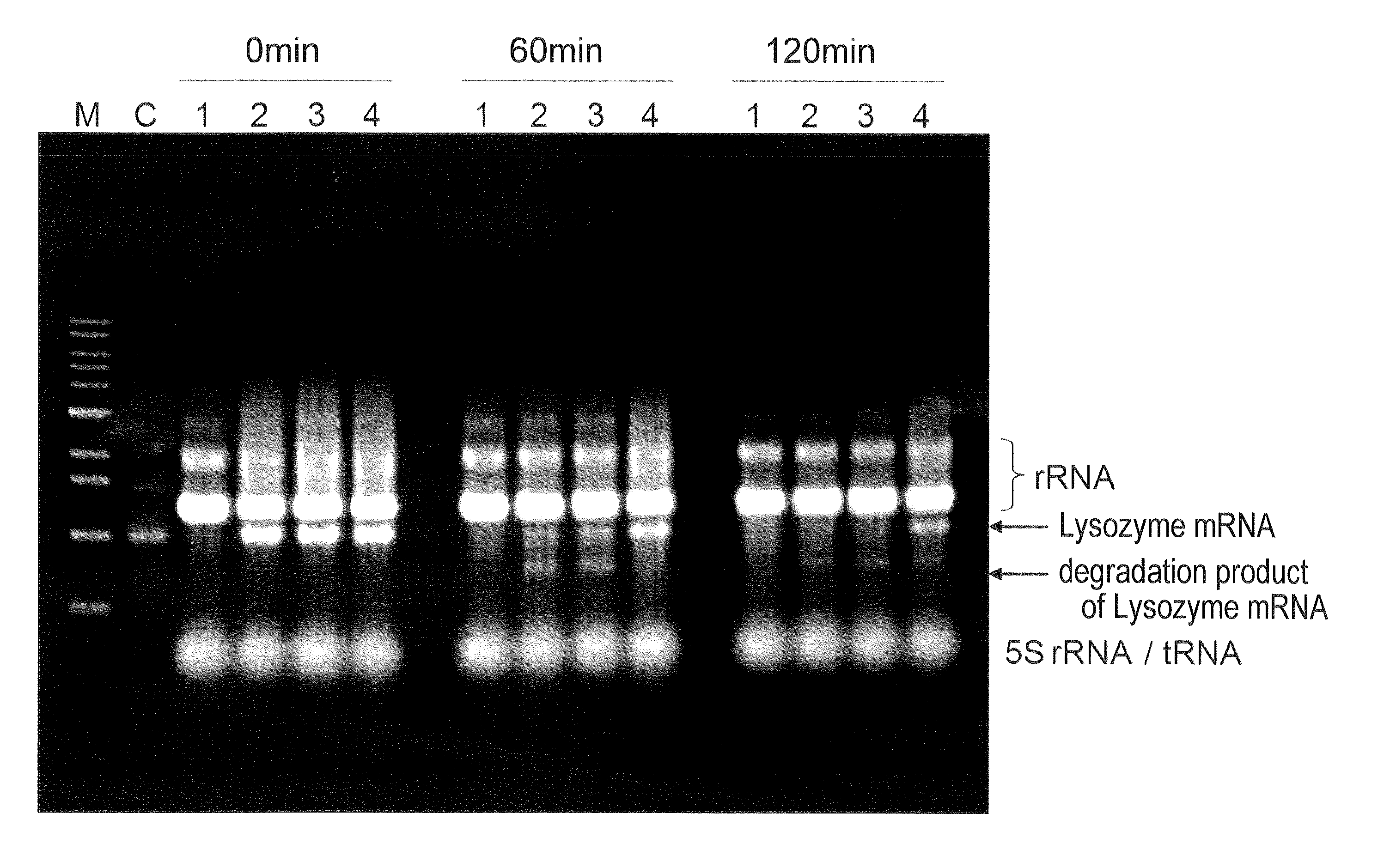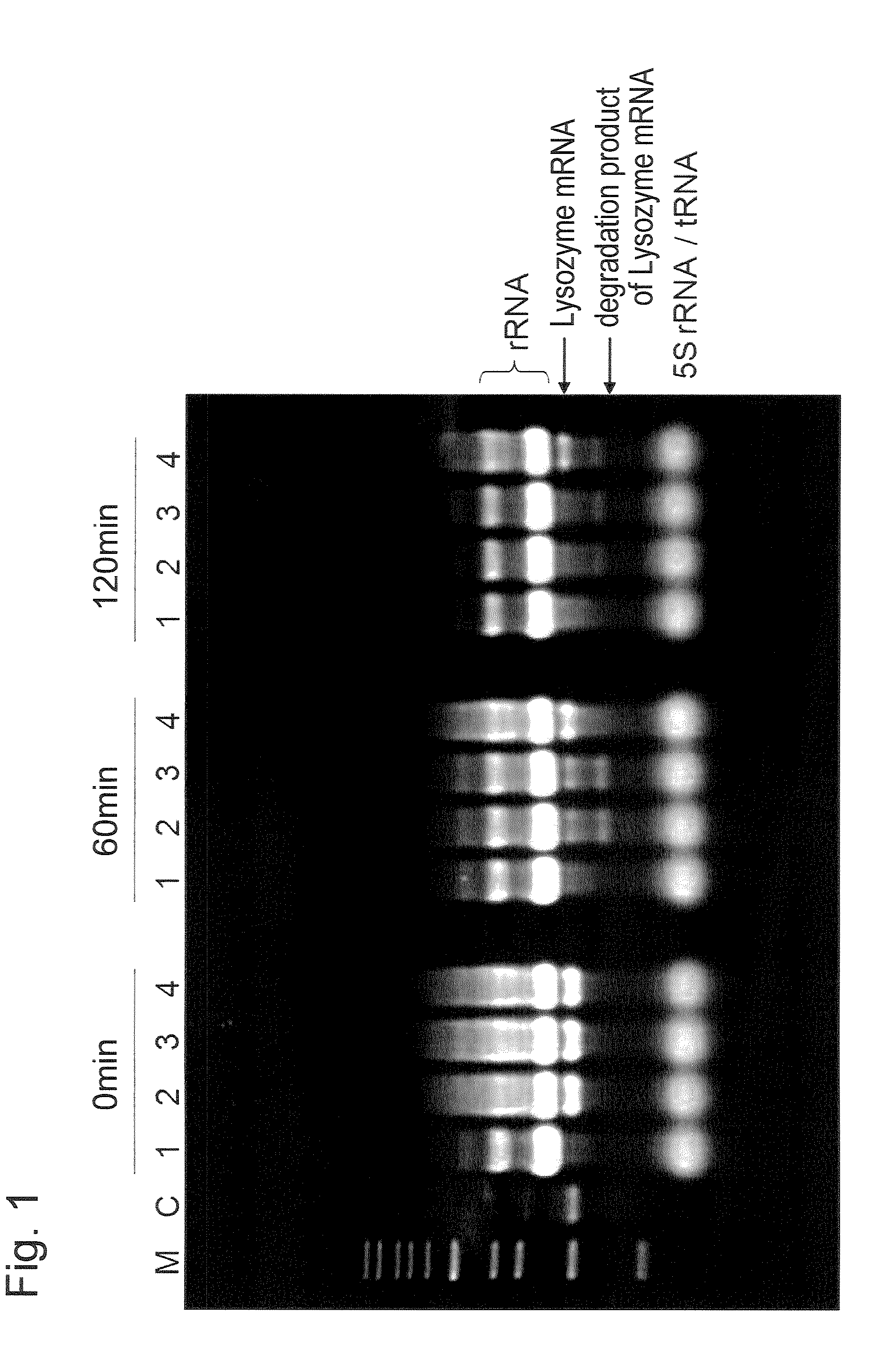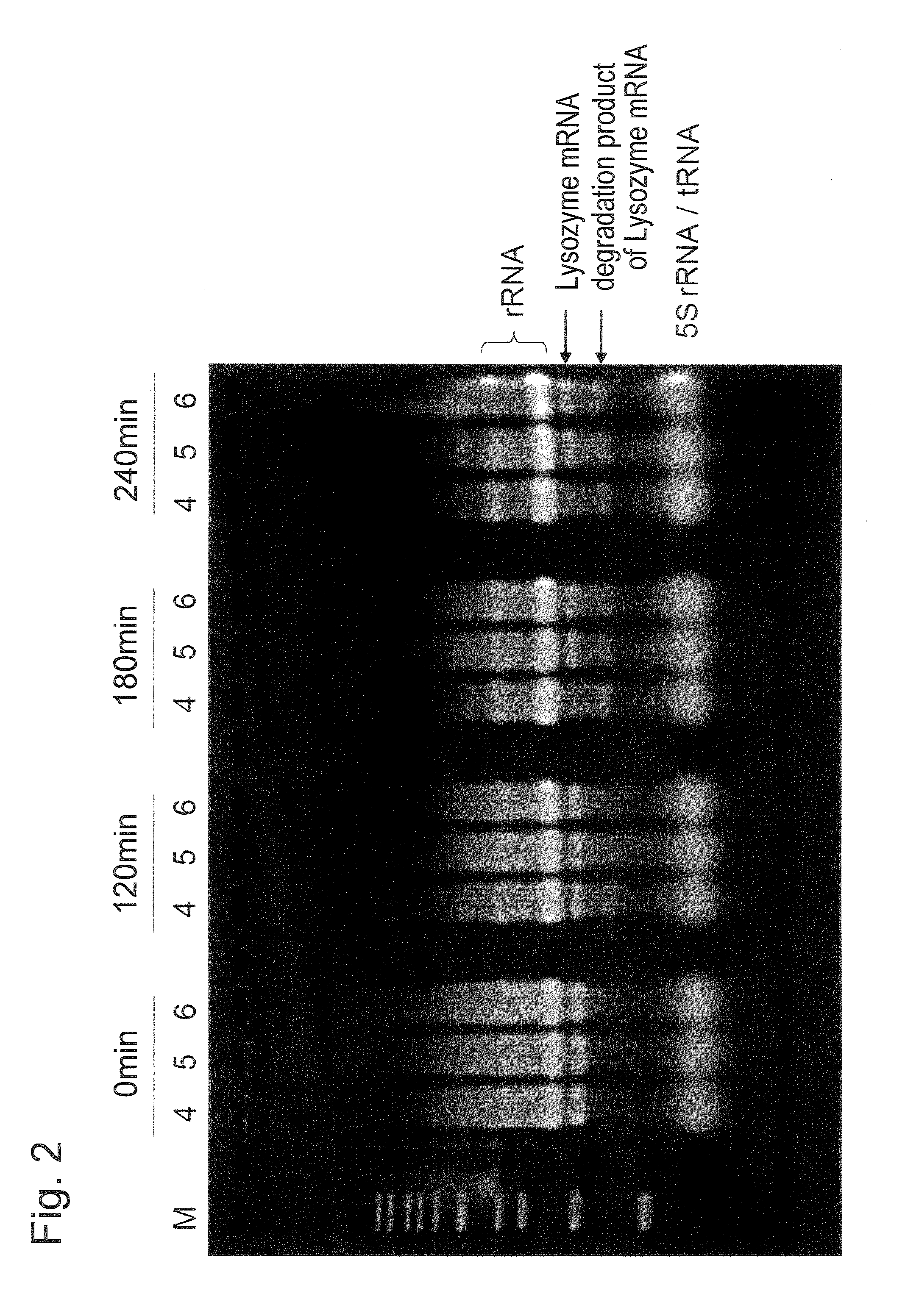Cell-free protein synthesis method and cell-free protein synthesis reaction solution using adenosine 3',5'-bisphosphate
a technology of adenosine and adenosine, which is applied in the field of cell-free protein synthesis method, can solve the problems of troublesome pre-treatment, low mrna activity, and inability to inhibit ribonuclease inhibitors, and achieve the effect of conveniently suppressing mrna degradation and suppressing mrna degradation
- Summary
- Abstract
- Description
- Claims
- Application Information
AI Technical Summary
Benefits of technology
Problems solved by technology
Method used
Image
Examples
example 1
Step 1. Construction of Expressing Plasmid
[0054]PCR was conducted by using a human lysozyme cDNA clone (pERI 8602, Kanaya et al., J. Biol. Chem. 1992, 267, 15111-15115) as a template, and using primer sets having sequences respectively shown by the SEQ ID NO.: 1 and SEQ ID NO.: 2 below, and KOD-Plus-(TOYOBO).
5′-ATGAAGGTTTTCGAGAGATGCG-3′(SEQ ID NO.: 1)5′-GGGGTACCAACACCACAACCTTGAACG-3′(SEQ ID NO.: 2)
[0055]The 5′-end of the DNA fragment amplified by PCR was phosphorylated by T4 Polynucleotide Kinase (TOYOBO), and digested by KpnI (TOYOBO). The resultant DNA was coupled to an EcoRV / KpnI site of pTD1 vector (SHIMADZU CORPORATION) by T4 ligase (Quick Ligation(™) Kit, Nebr.). A target plasmid derived from a clone obtained by transformation of E. coli DH5α was named pTD1-strep-h-LYZ (Ezure et al., Proteomics, in press).
Step 2. In Vitro Transcription Reaction and Purification of mRNA
[0056]Using the expressing plasmid pTD1-strep-h-LYZ created in the above step 1 as a template, PCR was conduct...
example 2
[0064]By the same steps as Steps 1 to 3 of Example 1, a translation reaction was conducted for the following reaction solutions.
Reaction Solution 4 (Test section of present invention):mRNAadded (final concentration 320 μg / mL)RNase inhibitornot addedpApadded (addition before reaction:final concentration 5 mM,supplementation: not conducted)Reaction Solution 5 (Test section of present invention):mRNAadded (final concentration 320 μg / mL)RNase inhibitornot addedpApadded (addition before reaction:final concentration 10 mM,supplementation: not conducted)Reaction Solution 6 (Test section of present invention):mRNAadded (final concentration 320 μg / mL)RNase inhibitornot addedpApadded (addition before reaction:final concentration 5 mM,supplementation: conducted)
[0065]As for Reaction Solution 6, pAp was added before the reaction so that the final concentration was 5 mM, and after 60 minutes from starting of the reaction, 2.5 μL of a 100 mM pAp aqueous solution prepared in step 3 was added. As a...
example 3
[0070]By the same steps as Steps 1 to 3 of Example 1, a translation reaction was conducted for the following reaction solutions.
Reaction Solution 4 (Test section of present invention):mRNAadded (final concentration 320 μg / mL)RNase inhibitornot addedpApadded (final concentration 5 mM)LiClnot addedReaction Solution 7 (Test section for comparison):mRNAadded (final concentration 320 μg / mL)RNase inhibitornot addedpApnot addedLiCladded (final concentration 50 mM)Reaction Solution 8 (Test section of present invention):mRNAadded (final concentration 320 μg / mL)RNase inhibitornot addedpApadded (final concentration 5 mM)LiCladded (final concentration 50 mM)
[0071]In Reaction Solutions 7 and 8, a 4M aqueous LiCl solution was prepared for stock, and using the stock solution, the final concentration in the reaction solution was adjusted to 50 mM.
[0072]Steps 4 and 5 were conducted in the same manner as in Example 1 except that for each reaction solution, the reaction solution was recovered after 0,...
PUM
| Property | Measurement | Unit |
|---|---|---|
| pH | aaaaa | aaaaa |
| concentration | aaaaa | aaaaa |
| concentration | aaaaa | aaaaa |
Abstract
Description
Claims
Application Information
 Login to View More
Login to View More - R&D
- Intellectual Property
- Life Sciences
- Materials
- Tech Scout
- Unparalleled Data Quality
- Higher Quality Content
- 60% Fewer Hallucinations
Browse by: Latest US Patents, China's latest patents, Technical Efficacy Thesaurus, Application Domain, Technology Topic, Popular Technical Reports.
© 2025 PatSnap. All rights reserved.Legal|Privacy policy|Modern Slavery Act Transparency Statement|Sitemap|About US| Contact US: help@patsnap.com



